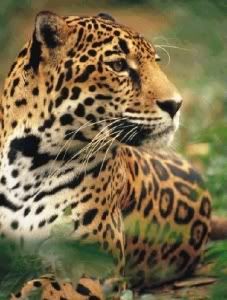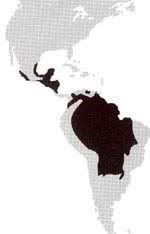


The jaguar's range
 Jaguar
Jaguar – Panthera onca
Common Name: Jaguar
Kingdom: Animalia
Phylum: Chordata (Vertebrata)
Class: Mammalia
Order: Carnivora
Family: Felidae
Genus: Pantherinae Panthera
Species: onca
The jaguar (Panthera onca) is the largest and most powerful cat of the Western Hemisphere, averaging up to 1.8 metres in length, not including the tail, and ranging in weight from 36 - 158 kilograms. A mature jaguar is powerfully built, with a massive head and shoulders, and thick, fairly short legs.
The jaguar is a largely solitary, stalk-and-ambush predator, and is opportunistic in prey selection. It is also an apex and keystone predator, playing an important role in stabilizing ecosystems and regulating the populations of prey species. The jaguar has developed an exceptionally powerful bite, even relative to the other big cats. This allows it to pierce the shells of armoured reptiles and to employ an unusual killing method with mammals: it bites directly through the skull of prey between the ears to deliver a fatal blow to the brain.
Jaguars are rarely seen in the wild due to their shy nature and their well-camouflaged coats. Most jaguars are yellowish to tawny in colour, spotted with large black rosettes or rings. Black (melanistic) and nearly all white (albino) jaguars are occasionally born.
The jaguar – symbol of power, strength and beauty – was worshipped as a god by early indigenous cultures, including the Aztecs, the Olmecs and the Maya. The name "jaguar" comes from a native Indian word meaning "the killer that takes its prey in a single bound."
Jaguars hunt mostly on the ground around dusk and dawn, but can climb well and sometimes will ambush prey by leaping from ledges or tree limbs.
Jaguars are excellent swimmers and have been seen swimming between islands, wading in shallow pools of water on hot days, and leaping into ponds and streams after fish and other aquatic life.
White Jaguar
Ghost jaguars have been reported in Paraguay, South America. They have grayish white fur with faint markings on the flanks. Albino jaguars with almost invisible markings have also been reported. Albino and partially albino jaguars have been reported from Paraguay. Spanish soldier-naturalist Don Felix de Azara described a jaguar so pale that its rosettes were only visible in certain lights. This corresponds to the pattern found on albino leopards . Rengger described a grayish white skin with faint shades of markings on the belly and flanks, the claws had been white according to the hunter who shot the animal.

